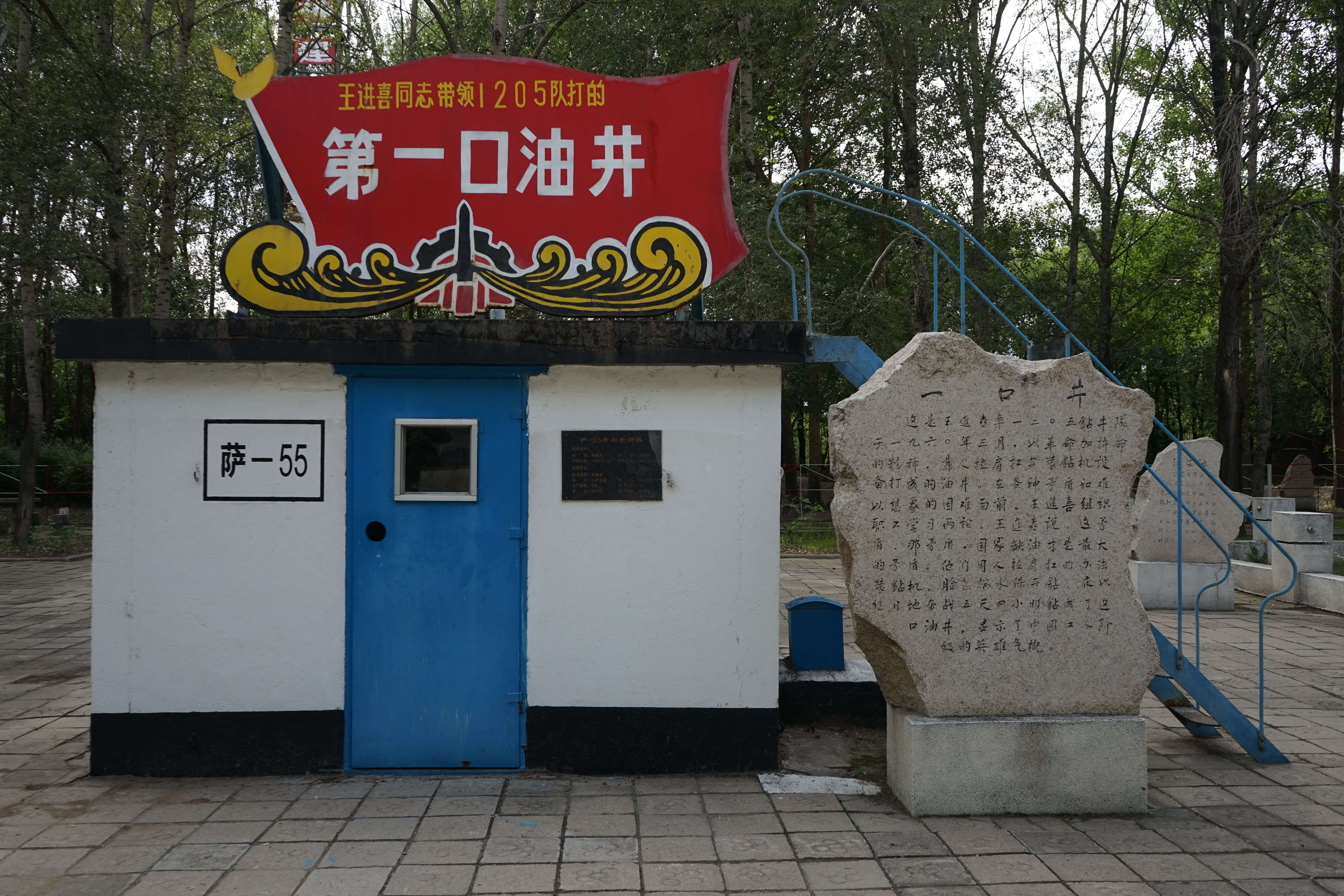|
Daqing Inaugural Oil Well
The Songji Three Oil Well, also known as The Daqing Inaugural Oil Well, is situated adjacent to Yongyue Village, Gaotaizi Town, Datong District, Daqing City, Heilongjiang Province. The well was drilled on April 11, 1958, and oil production commenced on September 26 of that year. The finding of the well marked the start of the Daqing institution. In April 1988, the well casing sustained a significant fracture that was irreparable, leading to the official cessation of production on July 25th of that year. In 2001, the well was included in Major cultural heritage sites under national-level protection. Investigation Since 1958, the Ministry of Geology and Mineral Resources and the Ministry of Petroleum Industry have coordinated personnel to drill the Songji one and Songji two wells in the Songliao Basin. Neither well exhibited industrial oil flow. In February 1959, following the organization of materials and an evaluation of exploration findings, the Ministry of Petroleum Industry det ... [...More Info...] [...Related Items...] OR: [Wikipedia] [Google] [Baidu] |
Daqing
Daqing () is a prefecture-level city in the west of Heilongjiang province, People's Republic of China. The name literally means "Great Celebration" and refers to the tenth anniversary of the PRC. Daqing is known as the "Oil Capital of China" and has experienced a phenomenal boom since oil was discovered at the Daqing Oil Field in 1959. Its population was 2,781,562 as of the 2020 Chinese census, 2020 census, of whom 1,574,389 lived in the built-up (or metro) area in four out of the total of five urban districts: Sartu, Longfeng District, Longfeng, Ranghulu and Honggang. History The region now known as Daqing Prefecture was a reasonably insignificant place until the Qing dynasty, known only as an unsettled hunting ground of Dörbet Oirat tribes due to its wetland and prairies. The region began to grow slightly after the Russian Empire constructed the Chinese Eastern Railway (KVZhD) through the area in 1898. The railway has a station at Sartu in today's Sartu District. It was not ... [...More Info...] [...Related Items...] OR: [Wikipedia] [Google] [Baidu] |
Heilongjiang Province
Heilongjiang is a province in northeast China. It is the northernmost and easternmost province of the country and contains China's northernmost point (in Mohe City along the Amur) and easternmost point (at the confluence of the Amur and Ussuri rivers). The province is bordered by Jilin to the south and Inner Mongolia to the west. It also shares a border with Russia ( Amur Oblast, Jewish Autonomous Oblast, Khabarovsk Krai, Primorsky Krai and Zabaykalsky Krai) to the north and east. The capital and the largest city of the province is Harbin. Among Chinese provincial-level administrative divisions, Heilongjiang is the sixth-largest by total area, the 20th-most populous, and the second-poorest by GDP per capita after only Gansu province. The province takes its name from the Amur river which marks the border between the People's Republic of China and Russia. Heilongjiang has significant agricultural production, and raw materials, such as timber, oil, and coal. Etymology Th ... [...More Info...] [...Related Items...] OR: [Wikipedia] [Google] [Baidu] |
Major Cultural Heritage Sites Under National-level Protection
A national priority protected site is the highest-level national protection for immovable cultural relics in China. The designation was first created under the 1961 Provisional Regulations on the Protection and Management of Cultural Relics, which evolved into the Law on the Protection of Cultural Relics. According to the 2002 Cultural Relics Protection Law of the People's Republic of China, the National Cultural Heritage Administration of the State Council of the People's Republic of China, State Council selects those with significant historical, artistic, and scientific value as national key cultural relics protection units. National key cultural relics protection units shall not be demolished; if they need to be relocated, they must be reported to the State Council for approval by applications from the people's government of the provincial administrative region. Statistics In 1999 it was reported that there were some 350,000 immovable cultural properties in China, of which 70, ... [...More Info...] [...Related Items...] OR: [Wikipedia] [Google] [Baidu] |
Oil Fields In China
An oil is any nonpolar chemical substance that is composed primarily of hydrocarbons and is hydrophobic (does not mix with water) and lipophilic (mixes with other oils). Oils are usually flammable and surface active. Most oils are unsaturated lipids that are liquid at room temperature. The general definition of oil includes classes of chemical compounds that may be otherwise unrelated in structure, properties, and uses. Oils may be animal, vegetable, or petrochemical in origin, and may be volatile or non-volatile. They are used for food (e.g., olive oil), fuel (e.g., heating oil), medical purposes (e.g., mineral oil), lubrication (e.g. motor oil), and the manufacture of many types of paints, plastics, and other materials. Specially prepared oils are used in some religious ceremonies and rituals as purifying agents. Etymology First attested in English 1176, the word ''oil'' comes from Old French ''oile'', from -4; we might wonder whether there's a point at which it's appro ... [...More Info...] [...Related Items...] OR: [Wikipedia] [Google] [Baidu] |


